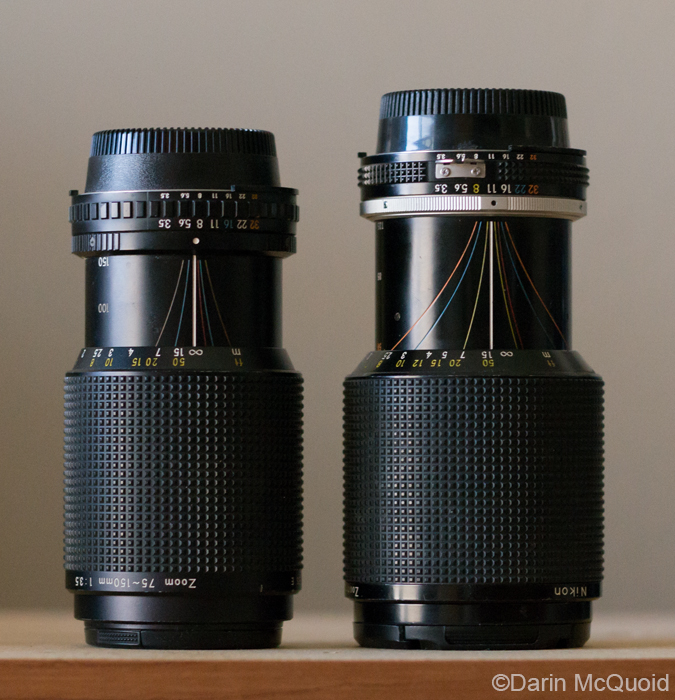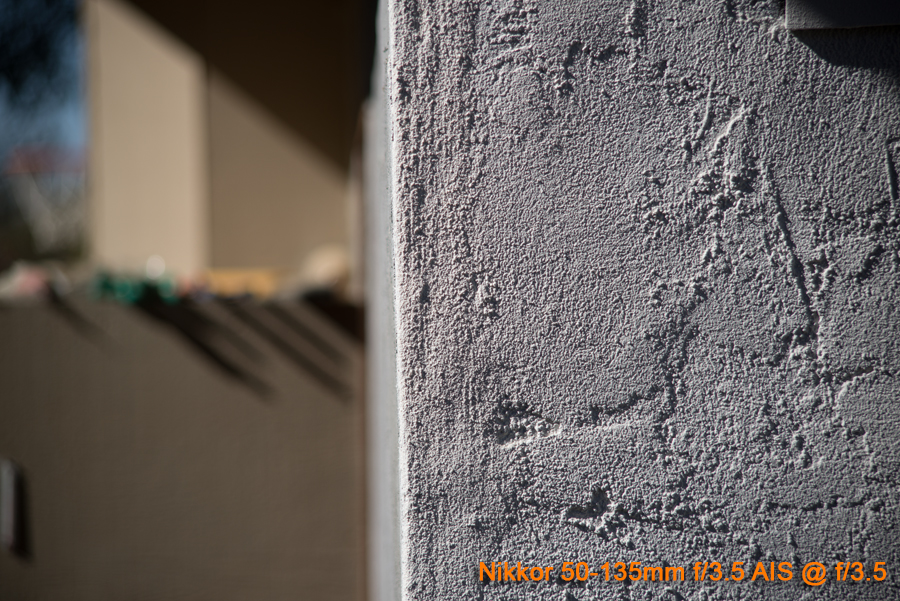
| Darin McQuoid | Blog | Reviews | Tutorials | River Directory |
Nikon
75-150mm f/3.5 Series E vs the Nikkor 50-135mm f/3.5 AIS


The Nikon 75-150mm f/3.5 Series E is a well known dark horse in the world of Nikon manual focus. Once considerably more expensive, the heavier and larger Nikkor 50-135mm f/3.5 AIS is not as well known. Used rates for both of these lenses stay within $50 of each other, so it's worth comparing the two on a demanding sensor: the 24mp Nikon D600. These both cover nice portrait to mild telephoto range, so I decide a nice boring half stucco wall was a good way to put these to the test. I decided around 100mm would be a nice portrait length that would allow the legendary Nikkor 105mm f/2.5 AIS to be thrown in the mix too. As the 50-135mm doesn't have 100mm markings I set it half way between 85mm and 135mm, which ended up being a little tighter. As per usual for these geeky photo tests, everything was shot on a tripod focused zoomed all the way in with live view using mirror lock up, white balance matched.
As with all lens tests, sample variation can play a huge role. All these lenses are in decent shape with no excessive dust or fungus, but other copies may perform better or worse. This wasn't as obvious with lenses until we got into the high megapixel sensors, but they are brutal for showing any issues.
First let's look at the oh so
popular
"bokeh" wide open (the 105 f/2.5 at both f/2.5 and f/4 to be fair)
Orange text for Halloween tomorrow. Click on the image to see them all
side by side.



To my eyes, even at f/4 the
105mm f/2.5
AIS does a better job with the basketball net and the 75-150mm f/3.5
comes in second, but it's a very subjective thing. By f/5.6 they
are
almost identical.
A quick look at center sharpness near wide open, f/4 is so close to f/3.5 we'll just go there. They are all pretty close, but the results are the opposite of what I would have expected, the 75-150mm has the least purple fringing and best detail at f/4.
A quick look at center sharpness near wide open, f/4 is so close to f/3.5 we'll just go there. They are all pretty close, but the results are the opposite of what I would have expected, the 75-150mm has the least purple fringing and best detail at f/4.
Corners
at f/4. Now
the 105mm is pulling away while the 50-150mm remains behind, and this
stays true down to f/8. All the lenses keep improving with the 105mm
sharp edge to edge, the 75-150mm showing just a trace of corner
softness and this copy of the 50-135mm still soft in the extreme
corner. F/8
corners here.
Full resolution raw files: 105mm at f/4, 50-135mm at f/3.5 and 75-150mm at f3.5.
Full resolution raw files: 105mm at f/4, 50-135mm at f/3.5 and 75-150mm at f3.5.
Not all is equal at different
focusing
distances, so here is a little bit of infinity focusing. I threw in the
Tamron 70-200mm f/2.8 VC to see just what $1,500 and forty years of
technology get you outside of weight, af and image stabilization. 100%
Center
crops and 100%
corner crops
at f/4. By the time we
get to f/8 we're splitting hairs. Remember that saying f/8
and be
there? If a lens isn't performing by now it's a true dog.

In the end they all have their
merits.
The 105mm f/2.5 AIS is the best tool for portraits, no surprise there.
Stopped down it doesn't gain a whole lot over the Nikon Series E
75-150mm f/3.5, which has a few issues. The filter ring rotates when
focusing making it a pain to use with polarizing filters, and on an
APS-C sized sensor it's not in that perfect portrait range anymore, but
it's the cheapest of the bunch.
The surprise is that the heaviest and once most expensive Nikkor 50-150mm f/3.5 is the lowest performing of the three. On the upside the filter ring doesn't rotate while focusing and on an APS-C sensor it makes a very nice 70-200mm equivalent, where the corners are no longer in play either.
The surprise is that the heaviest and once most expensive Nikkor 50-150mm f/3.5 is the lowest performing of the three. On the upside the filter ring doesn't rotate while focusing and on an APS-C sensor it makes a very nice 70-200mm equivalent, where the corners are no longer in play either.